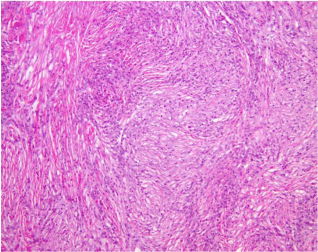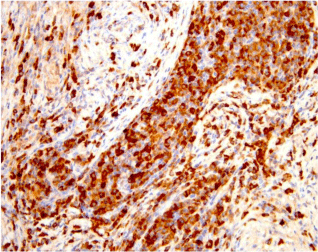Case Report
Igg4 Related Cutaneous Inflammatory Pseudotumour: A Rare Case and Review of the Litesrature
Kinton L, Arun A*, Harmse D and Akoh JA
Department of Oesophago Gastric & General Surgery, Derriford Hospital, UK
*Corresponding author: Arun Ariyarathenam Department of General Surgery, Derriford Hospital, Plymouth, UK
Published: 07 Dec, 2016
Cite this article as: Kinton L, Arun A, Harmse D, Akoh JA.
Igg4 Related Cutaneous Inflammatory
Pseudotumour: A Rare Case and
Review of the Litesrature. Clin Surg.
2016; 1: 1217.
Abstract
IgG4-related disease also known as inflammatory pseudotumour and include myofibroblastic tumours and plasma cell granulomas, has recently become a recognised condition. The aetiology
remains unknown, with features of both allergic and autoimmune disease. We present here such a
rare case and review published cases of the disease.
We present a 42 year old female patient who underwent an excision of a suspected sebaceous cyst,
which was confirmed as IgG4 related disease. The patient underwent a further wide local excision
due to her choice, with no evidence of recurrent disease on follow up.
IgG4 related disease can present in any organ, but occur mostly to the lung, biliary tract, pancreas
and the salivary gland. The visceral inflammatory pseudo tumour manifest very differently to
cutaneous manifestations of the disease, with only 17 cases reported in the English literature of this
condition noted to affect the skin. The cutaneous disease behaves in a benign fashion with good
outcomes from surgical excision with no current evidence in the literature of local recurrence.
This report adds another case of cutaneous IgG4 disease to the literature and reviews previously
published cases.
Introduction
IgG4 related disease or inflammatory pseudotumour (IPT) is the overarching name given to
myofibroblastic tumours and plasma cell granulomas [1]. This disease commonly affects visceral
organs in the thorax, central nervous system, biliary tract, pancreas, spleen, kidneys, pelvic region
and salivary glands [2]. Cutaneous involvement is rare [3], with only 17 cases reported in the English
literature. This report adds another case of cutaneous IgG4 disease to the literature and reviews
previously published cases.
In all these cases tumour behavior has been in a benign fashion with no recurrence post surgical
excision.
Case Presentation
A 42 year old Caucasian female was referred by her general practitioner to the general surgeons
with a suspected sebaceous cyst, measuring 2 cm in diameter, on her right lower flank. It was tender
to palpation and noted to be discharging pus. The patient had been previously treated with several
courses of oral antibiotics prior to the referral. Her past medical history included well-controlled
epilepsy and asthma.
A routine surgical excision was performed under local anesthetic as a day case procedure and
the specimen was sent for histology. This showed normal epidermis but within the dermis and
superficial subcutaneous fat, there was spindle cell proliferation comprising blunt-ended spindle
cells within pale cytoplasm, forming whorls and fascicles in a sclerotic stroma. Surrounding the
spindle cell proliferation there was chronic inflammation in the form of lymphoid aggregates, some
with reactive germinal centers and numerous plasma cells. No cyst was seen. The histology concluded
that the features represented spindle cell proliferation with chronic inflammatory infiltrate, as an
inflammatory pseudotumour such as can be seen post-arthropod bite or post a localized vasculitis
(Figure 1). Immunohistochemistry revealed the plasma cells to be polyclonal. The blunt-ended
spindle cells with pale cytoplasm showed some staining for CD68 and were negative for S100 and
ALK-1, desmin, SMA and CD34 (Figure 2).
Following discussion at the Dermatology Multidisciplinary team meeting, the option of careful
observation versus a wider local excision was discussed with the
patient. A wider local excision was performed successfully after four
weeks from the initial surgery. Follow up from the second surgery at
six weeks, showed no clinical evidence of reoccurrence and, despite
the scar being sensitive, was healing well.
Figure 1
Figure 2
Figure 2
Histology showing the blunt-ended spindle cells with pale cytoplasm showed some staining for CD68 and were negative for S100 and ALK-1, desmin, SMA and CD34.
Table 1
Table 1
Summary of all cases with patient demographics and anatomical sites
of lesion that have been reported in literature.
Discussion
Umiker et al. [4] described the first IPT in the lung in the 1950’s noting that the tumour was due to post inflammatory change rather
than a neoplastic process. ITPs have since been found in many organs
of the body, but pulmonary IPTs remain most common: therefore
tumours are commonly classified as being pulmonary or extrapulmonary.
Coffin et al. [5] in 1995 described the differences and
similarities between IPT and inflammatory fibrosarcoma. IPTs have
become recognized as a separate entity only in the last 20 years and
despite improvements in histological and clinical examination, is still
unclear whether they are due to a post inflammatory change (infection
or chronic vasculitis), or a true neoplastic change. Currently the
histological diagnosis of an IPT is based on the presence of polyclonal
plasma cell infiltrate and fascicles of spindle cells [6].
In 2005 Arber et al. [7] found a high proportion of extrapulmonary
tumours to have the Epstein-Barr virus present in them.
They tested tumours originating in lymph nodes, the spleen and
hepatic nodules and EBV was present in 41.2% of these tumours.
Cutaneous IPT is extremely rare and only 17 cases have been noted
in the English language literature [2,9-17]. The patient demographics
and anatomic locations of the lesions in these cases have been
summarised (Table 1). In all but one of the reported cases of
cutaneous IPT, surgical excision of the lesion has been the treatment
of choice with good outcomes. For visceral disease, (more common
in children) non-steroidal anti-inflammatory drug therapy has been
shown to have good effect [17]. Visceral IPTs are highly vascularised
and unlike cutaneous IPTs are associated with a risk of infiltration,
local recurrence and rarely known to metastasise.
The paper adds another case to the growing literature on IPTs,
advocating surgical resection with good margins for most cutaneous
lesions. In this case the patient opted to have a wider local excision,
which showed no further tumour growth and clear margins hence
further resection was not required. We believe the pathogenesis and
management of the condition is still evolving and not much is known
about the risk of recurrence of the tumour. Though the neoplastic
nature of the disease is still debated the accumulated evidence of
surgical excision suggests that wide local excision is not required.
References
- Elder DE. Lever's Histopathology of the Skin. 10th ed. London: Lippincott Williams and Wilkins. 2009; 993.
- El Shabrawi-Caelen L, Kerl K, Cerroni L, Soyer HP, Kerl H. Cutaneous inflammatory pseudotumor. J Cutan Pathol. 2004; 31: 605-611.
- Frey J, Huerter C, Shehan J. Inflammatory Pseudotumor of the Skin: A Case Report And Review Of The Literature. The Internet J of Derm. 2006; 6.
- Umiker WO, Iverson L. Postinflammatory tumors of the lung; report of four cases simulating xanthoma, fibroma, or plasma cell tumor. J Thorac Surg. 1954; 28: 55-63.
- Coffin CM, Watterson J, Priest JR, Dehner LP. Extrapulmonary inflammatory myofibroblastic tumor (inflammatory pseudotumor). A clinicopathologic and immunohistochemical study of 84 cases. Am J Surg Pathol. 1995; 19: 859-872.
- Mohammad Ali El-Darouti. An Unusual Kerion-like Scalp Tumor. In: Unknown Challenging Cases in Dermatology. London: Springer; 2013: 421-425.
- Arber DA, Kamel OW, van de Rijn M, Davis RE, Medeiros LJ, Jaffe ES, et al. Frequent presence of Epstein-Barr virus in inflammatory pseudotumour. Hum Pathol. 1995; 26: 1093-1098.
- Applebaum H, Kieran MW, Cripe TP, Coffin CM, Collins MH, Kaipainen A, et al. The rationale for nonsteroidal anti-inflammatory drug therapy for inflammatory myofibroblastic tumors: a Children's Oncology Group study. J Pediatr Surg. 2005; 40: 999-1003.
- Hurt MA, Santa Cruz DJ. Cutaneous inflammatory pseudotumor. Lesions resembling "inflammatory pseudotumors" or "plasma cell granulomas" of extracutaneous sites. Am J Surg Pathol. 1990; 14: 764-773.
- Yang M. Cutaneous inflammatory pseudotumor: a case report with immunohistochemical and ultrastructural studies. Pathology. 1993; 25: 405-409.
- Vadmal MS, Pellegrini AE. Inflammatory myofibroblastic tumor of the skin. Am J Dermatopathol. 1999; 21: 449-453.
- Nakajima T, Sano S, Itami S, Yoshikawa K. Cutaneous inflammatory pseudotumour (plasma cell granuloma). Br J Dermatol. 2001; 144: 1271- 1273.
- Yung A, Merchant W, Goulden V. A case of isolated cutaneous pseudoinflammatory tumour. Clin Exp Dermatol. 2005; 30: 369-372.
- Saricaoglu H, Akin S, Adim SB, Karadogan SK. Cutaneous inflammatory pseudotumour. J Eur Acad Dermatol Venereol. 2006; 20: 750-751.
- Pagni F. Cutaneous inflammatory pseudotumor (plasmocytoid granuloma). Pathologica. 2007; 99: 84-86.
- González-Vela MC, Val-Bernal JF, Arce FP, Gómez-Roman J, González- López MA, Fernández-Llaca JH. Presence of human herpesvirus-8 in inflammatory myofibroblastic tumor of the skin. J Eur Acad Dermatol Venereol. 2007; 21: 399-401.
- Su W, Ko A, O’Connell T, Applebaum H. Treatment of psuedotumors with nonsteroidal anti-inflammatory drugs. J Pediatr Surg. 2000; 35: 1634-1637.



